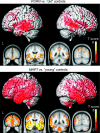Voxel-based morphometry patterns of atrophy in FTLD with mutations in MAPT or PGRN
- PMID: 19255408
- PMCID: PMC2677544
- DOI: 10.1212/01.wnl.0000343851.46573.67
Voxel-based morphometry patterns of atrophy in FTLD with mutations in MAPT or PGRN
Abstract
Objective: To compare patterns of gray matter loss in subjects with mutations in the progranulin (PGRN) gene to subjects with mutations in the microtubule-associated protein tau (MAPT) gene.
Methods: We identified all subjects seen at the Mayo Clinic, Rochester, MN, who had screened positive for mutations in PGRN or MAPT and had a head MRI. Twelve cases with mutations in the PGRN gene were matched by time from disease onset to scan to 12 subjects with mutations in the MAPT gene. Voxel-based morphometry was used to assess patterns of gray matter loss in the PGRN and MAPT groups compared to a control cohort, and compared to each other. MAPT subjects were younger than the PGRN subjects; therefore, each group was also compared to a specific age-matched control group.
Results: Both PGRN and MAPT groups showed gray matter loss in frontal, temporal, and parietal lobes compared to controls, although loss was predominantly identified in posterior temporal and parietal lobes in PGRN and anteromedial temporal lobes in MAPT. The MAPT group had greater loss compared to healthy subjects of the same age than the PGRN subjects when compared to healthy subjects of the same age. The MAPT subjects showed greater gray matter loss in the medial temporal lobes, insula, and putamen than the PGRN subjects.
Conclusion: These results increase understanding of the biology of these disorders and suggest that patterns of atrophy on MRI may be useful to aid in the differentiation of groups of PGRN and MAPT mutation carriers.
Figures



References
-
- Hutton M, Lendon CL, Rizzu P, et al. Association of missense and 5′-splice-site mutations in tau with the inherited dementia FTDP-17. Nature 1998;393:702–705. - PubMed
-
- Rademakers R, Cruts M, van Broeckhoven C. The role of tau (MAPT) in frontotemporal dementia and related tauopathies. Hum Mutat 2004;24:277–295. - PubMed
-
- Baker M, Mackenzie IR, Pickering-Brown SM, et al. Mutations in progranulin cause tau-negative frontotemporal dementia linked to chromosome 17. Nature 2006;442:916–919. - PubMed
Publication types
MeSH terms
Substances
Grants and funding
LinkOut - more resources
Full Text Sources
Medical
Molecular Biology Databases
Miscellaneous
